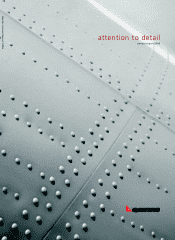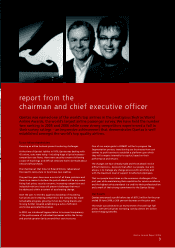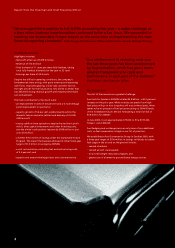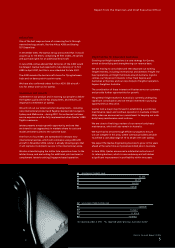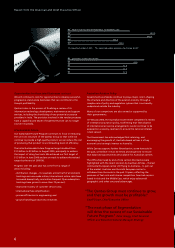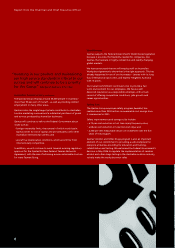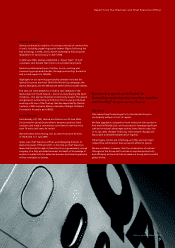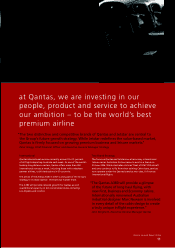Qantas 2006 Annual Report Download - page 6
Download and view the complete annual report
Please find page 6 of the 2006 Qantas annual report below. You can navigate through the pages in the report by either clicking on the pages listed below, or by using the keyword search tool below to find specific information within the annual report.
Report from the Chairman and Chief Executive Officer
Our Results continued
Highlights included:
• Net profi t after tax of $479.5 million
• Revenue of $13.6 billion
• Final dividend of 11 cents per share fully franked, taking
total fully franked dividends for the year to 22 cents
• Earnings per share of 24.9 cents
Despite the difficult operating conditions, the company’s
fundamentals were strong, with good revenues and operating
cash fl ows, improved gearing, world-class customer service,
the right aircraft for the future and a new airline in Jetstar that
has delivered strong revenue growth and industry benchmark
cost containment.
The main contributors to the result were:
• an improvement in yield of 5.8 per cent and a 0.7 percentage
point improvement in seat factor;
• capacity growth of 3.6 per cent, predominantly within the
domestic leisure market as Jetstar took delivery of its 24th
A320 aircraft;
• strong cashfl ow from operations despite the decline in profi t
which, after capital investments and other fi nancing costs,
saw the airline’s cash position improve by $998 million to just
over $2.9 billion;
• a further $501 million of savings under the Sustainable Future
Program. This meant the business achieved its initial three-year
target of $1.5 billion in savings by 2005/06;
• a unit cost reduction, excluding fuel and restructuring costs,
of 2.2 per cent; and
• superior and award-winning product and customer service.
The Cost of Fuel
The cost of fuel remains our greatest challenge.
Fuel costs for Qantas in 2005/06 totalled $2.8 billion – a 45.1 per cent
increase on the prior year. While nobody can predict how high
fuel prices will go or how long they will stay at these levels, there
seems to be no prospect of fuel prices returning to 2004/05 levels
in the foreseeable future. We are forecasting a total fuel bill of
$3.9 billion for 2006/07.
In June 2003, it cost approximately $75,000 to fi ll a B747-400.
Today it costs $180,000.
Fuel hedging and surcharges recover only some of our additional
costs, so fuel conservation is high on our list of priorities.
We established a Fuel Conservation Group in October 2005, with
a three-year target of $100 million in savings. Initiatives to reduce
fuel usage in the air and on the ground include:
• revised schedules;
• revised aircraft cruise speeds;
• an aircraft weight reduction program; and
• greater use of alternative ground-based energy sources.
“Our achievement in reducing costs over
the last three years has been underpinned
by Segmentation, which has given much
greater transparency to costs and
performance in each part of the business.”
Geoff Dixon, Chief Executive Officer
“We managed the transition to full A-IFRS accounting this year – a major challenge at
a time when business transformation continued to be a key focus. We succeeded in
meeting our Sustainable Future targets at the same time as implementing the new
fi nancial reporting standards.“ Peter Gregg, Chief Financial Officer and Executive General Manager Strategy
4

